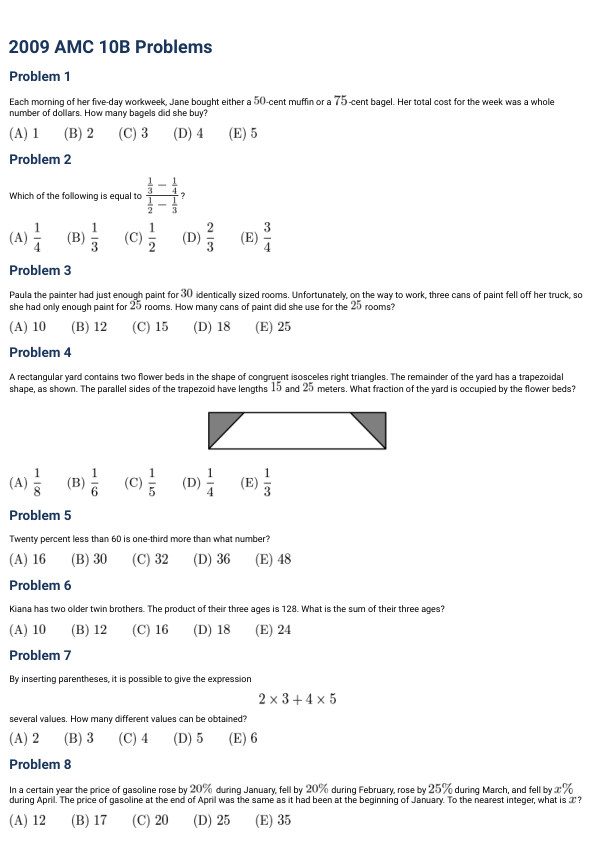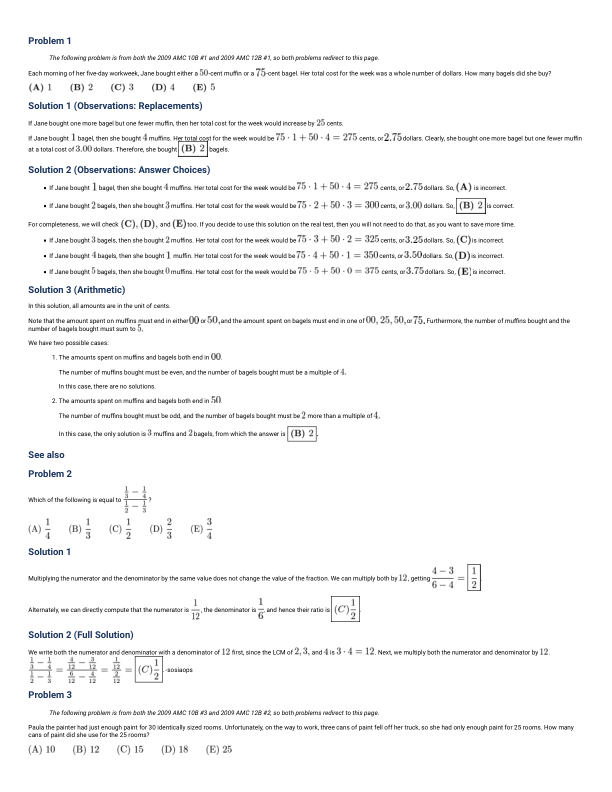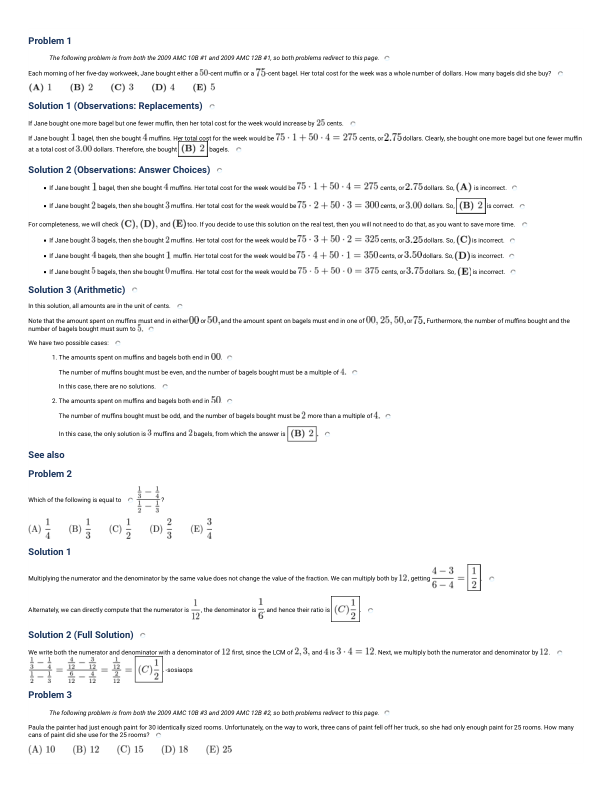2009 AMC amc10b 真题 答案 详解
| 序号 | 文件列表 | 说明 | ||
|---|---|---|---|---|
| 1 | 2009-amc10b-paper-eng.pdf | 5 页 | 211.00KB | 英文真题 |
| 2 | 2009-amc10b-key.pdf | 1 页 | 10.27KB | 真题答案 |
| 3 | 2009-amc10b-solution-eng.pdf | 18 页 | 1.33MB | 真题文字详解(英文) |
| 4 | 2009-amc10b-solution-eng-zh.pdf | 18 页 | 1.48MB | 真题文字详解(中英双语) |
英文真题
2009 AMC 10B Problems
Problem 1
Each morning of her five-day workweek, Jane bought either a $50$-cent muffin or a $75$-cent bagel. Her total cost for the week was a whole number of dollars. How many bagels did she buy?
(A) $1$ (B) $2$ (C) $3$ (D) $4$ (E) $5$
Problem 2
Which of the following is equal to $\frac{\frac{1}{3} - \frac{1}{4}}{\frac{1}{2} - \frac{1}{3}}?$
(A) $\frac{1}{4}$ (B) $\frac{1}{3}$ (C) $\frac{1}{2}$ (D) $\frac{2}{3}$ (E) $\frac{3}{4}$
Problem 3
Paula the painter had just enough paint for $30$ identically sized rooms. Unfortunately, on the way to work, three cans of paint fell off her truck, so she had only enough paint for $25$ rooms. How many cans of paint did she use for the $25$ rooms?
(A) $10$ (B) $12$ (C) $15$ (D) $18$ (E) $25$
Problem 4
A rectangular yard contains two flower beds in the shape of congruent isosceles right triangles. The remainder of the yard has a trapezoidal shape, as shown. The parallel sides of the trapezoid have lengths $15$ and $25$ meters. What fraction of the yard is occupied by the flower beds?
(A) $\frac{1}{8}$ (B) $\frac{1}{6}$ (C) $\frac{1}{5}$ (D) $\frac{1}{4}$ (E) $\frac{1}{3}$
Problem 5
Twenty percent less than $60$ is one-third more than what number?
(A) $16$ (B) $30$ (C) $32$ (D) $36$ (E) $48$
Problem 6
Kiana has two older twin brothers. The product of their three ages is $128$. What is the sum of their three ages?
(A) $10$ (B) $12$ (C) $16$ (D) $18$ (E) $24$
Problem 7
By inserting parentheses, it is possible to give the expression $2\times 3+4\times 5$ several values. How many different values can be obtained?
(A) $2$ (B) $3$ (C) $4$ (D) $5$ (E) $6$
Problem 8
In a certain year the price of gasoline rose by $20\%$ during January, fell by $20\%$ during February, rose by $25\%$ during March, and fell by $x\%$ during April. The price of gasoline at the end of April was the same as it had been at the beginning of January. To the nearest integer, what is $x?$
(A) $12$ (B) $17$ (C) $20$ (D) $25$ (E) $35$

真题文字详解(英文)
Problem 1 The following problem is from both the 2009 AMC 10B #1 and 2009 AMC 12B #1, so both problems redirect to this page. Each morning of her five-day workweek, Jane bought either a $50$-cent muffin or a $75$-cent bagel. Her total cost for the week was a whole number of dollars. How many bagels did she buy?
(A) $1$ (B) $2$ (C) $3$ (D) $4$ (E) $5$
Solution 1 (Observations: Replacements) If Jane bought one more bagel but one fewer muffin, then her total cost for the week would increase by $25$ cents. If Jane bought $1$ bagel, then she bought $4$ muffins. Her total cost for the week would be $75 \cdot 1 + 50 \cdot 4 = 275$ cents, or $2.75$ dollars. Clearly, she bought one more bagel but one fewer muffin at a total cost of $3.00$ dollars. Therefore, she bought (B) $2$ bagels.
Solution 2 (Observations: Answer Choices) - If Jane bought $1$ bagel, then she bought $4$ muffins. Her total cost for the week would be $75 \cdot 1 + 50 \cdot 4 = 275$ cents, or $2.75$ dollars. So, (A) is incorrect. - If Jane bought $2$ bagels, then she bought $3$ muffins. Her total cost for the week would be $75 \cdot 2 + 50 \cdot 3 = 300$ cents, or $3.00$ dollars. So, (B) $2$ is correct. For completeness, we will check (C), (D), and (E) too. If you decide to use this solution on the real test, then you will not need to do that, as you want to save more time. - If Jane bought $3$ bagels, then she bought $2$ muffins. Her total cost for the week would be $75 \cdot 3 + 50 \cdot 2 = 325$ cents, or $3.25$ dollars. So, (C) is incorrect. - If Jane bought $4$ bagels, then she bought $1$ muffin. Her total cost for the week would be $75 \cdot 4 + 50 \cdot 1 = 350$ cents, or $3.50$ dollars. So, (D) is incorrect. - If Jane bought $5$ bagels, then she bought $0$ muffins. Her total cost for the week would be $75 \cdot 5 + 50 \cdot 0 = 375$ cents, or $3.75$ dollars. So, (E) is incorrect.
Solution 3 (Arithmetic) In this solution, all amounts are in the unit of cents. Note that the amount spent on muffins must end in either $00$ or $50$, and the amount spent on bagels must end in one of $00$, $25$, $50$, or $75$. Furthermore, the number of muffins bought and the number of bagels bought must sum to $5$. We have two possible cases: 1. The amounts spent on muffins and bagels both end in $00$. The number of muffins bought must be even, and the number of bagels bought must be a multiple of $4$. In this case, there are no solutions. 2. The amounts spent on muffins and bagels both end in $50$. The number of muffins bought must be odd, and the number of bagels bought must be $2$ more than a multiple of $4$. In this case, the only solution is $3$ muffins and $2$ bagels, from which the answer is (B) $2$.
See also Problem 2 Which of the following is equal to $\frac{1}{2} - \frac{1}{3}$ ?
(A) $\frac{1}{4}$ (B) $\frac{1}{3}$ (C) $\frac{1}{2}$ (D) $\frac{2}{3}$ (E) $\frac{3}{4}$ Solution 1 Multiplying the numerator and the denominator by the same value does not change the value of the fraction. We can multiply both by $12$, getting $\frac{4 - 3}{6 - 4} = \frac{1}{2}$. Alternatively, we can directly compute that the numerator is $\frac{1}{12}$, the

真题文字详解(中英双语)
Problem 1 The following problem is from both the 2009 AMC 10B #1 and 2009 AMC 12B #1, so both problems redirect to this page. Each morning of her five-day workweek, Jane bought either a $50$-cent muffin or a $75$-cent bagel. Her total cost for the week was a whole number of dollars. How many bagels did she buy?
(A) $1$ (B) $2$ (C) $3$ (D) $4$ (E) $5$
Solution 1 (Observations: Replacements)
If Jane bought one more bagel but one fewer muffin, then her total cost for the week would increase by $25$ cents.
If Jane bought $1$ bagel, then she bought $4$ muffins. Her total cost for the week would be $75 \cdot 1 + 50 \cdot 4 = 275$ cents, or $2.75$ dollars. Clearly, she bought one more bagel but one fewer muffin at a total cost of $3.00$ dollars. Therefore, she bought (B) $2$ bagels.
Solution 2 (Observations: Answer Choices)
- If Jane bought $1$ bagel, then she bought $4$ muffins. Her total cost for the week would be $75 \cdot 1 + 50 \cdot 4 = 275$ cents, or $2.75$ dollars. So, (A) is incorrect.
- If Jane bought $2$ bagels, then she bought $3$ muffins. Her total cost for the week would be $75 \cdot 2 + 50 \cdot 3 = 300$ cents, or $3.00$ dollars. So, (B) $2$ is correct.
For completeness, we will check (C), (D), and (E) too. If you decide to use this solution on the real test, then you will not need to do that, as you want to save more time.
- If Jane bought $3$ bagels, then she bought $2$ muffins. Her total cost for the week would be $75 \cdot 3 + 50 \cdot 2 = 325$ cents, or $3.25$ dollars. So, (C) is incorrect.
- If Jane bought $4$ bagels, then she bought $1$ muffin. Her total cost for the week would be $75 \cdot 4 + 50 \cdot 1 = 350$ cents, or $3.50$ dollars. So, (D) is incorrect.
- If Jane bought $5$ bagels, then she bought $0$ muffins. Her total cost for the week would be $75 \cdot 5 + 50 \cdot 0 = 375$ cents, or $3.75$ dollars. So, (E) is incorrect.
Solution 3 (Arithmetic)
In this solution, all amounts are in the unit of cents.
Note that the amount spent on muffins must end in either $00$ or $50$, and the amount spent on bagels must end in one of $00$, $25$, $50$, or $75$. Furthermore, the number of muffins bought and the number of bagels bought must sum to $5$.
We have two possible cases:
1. The amounts spent on muffins and bagels both end in $00$.
The number of muffins bought must be even, and the number of bagels bought must be a multiple of $4$. In this case, there are no solutions.
2. The amounts spent on muffins and bagels both end in $50$.
The number of muffins bought must be odd, and the number of bagels bought must be $2$ more than a multiple of $4$.
In this case, the only solution is $3$ muffins and $2$ bagels, from which the answer is (B) $2$.
See also Problem 2
Which of the following is equal to $\frac{\frac{1}{3} - \frac{1}{4}}{\frac{1}{2} - \frac{1}{3}}$?
(A) $\frac{1}{4}$ (B) $\frac{1}{3}$ (C) $\frac{1}{2}$ (D) $\frac{2}{3}$ (E) $\frac{3}{4}$
Solution 1
Multiplying the numerator and the denominator by the same value does not change the value of the fraction. We can multiply both by $12$, getting $\frac{4 - 3}{6 -

